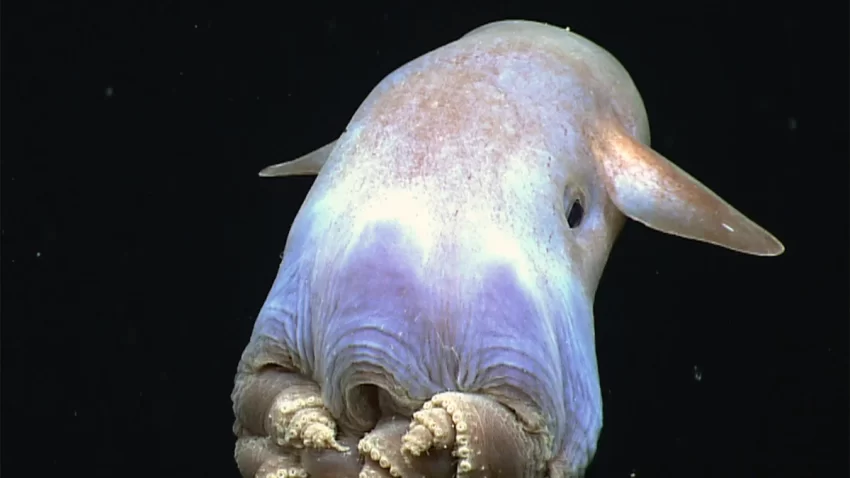The ocean’s depths offer a plethora of secrets, and the domain of deep-sea organisms stands out as a monument to evolution’s miracles. For decades, scientists and explorers have been attracted by these strange and alien species that live in the darkest and most hostile places. This article will dig into the interesting world of strange organisms found in the deep water, providing light on their unique adaptations, astounding appearances, and ongoing discoveries that continue to amaze us.
The Anglerfish: Master of Deception
The anglerfish is a well-known deep-sea species, known for its unusual look and hunting method. The anglerfish entices unwary food into its huge jaws by dangling a bioluminescent bait from its forehead. This adaption allows it to flourish in the deep sea’s darkness, where food is sparse and vision is limited. The anglerfish’s unusual look and predatory abilities make it a real natural wonder.
The Giant Isopod: A Living Fossil
 Imagine coming face to face with a football-sized woodlouse. That’s exactly how it would feel to come upon a massive isopod in the deep water. These ancient arthropods, often known as living fossils, have stayed almost unaltered for millions of years. Giant isopods are well-suited to living on the ocean floor due to their hardened exoskeleton and scavenging activity. Scientists researching the secrets of the deep water are fascinated by their sheer size and archaic aspect.
Imagine coming face to face with a football-sized woodlouse. That’s exactly how it would feel to come upon a massive isopod in the deep water. These ancient arthropods, often known as living fossils, have stayed almost unaltered for millions of years. Giant isopods are well-suited to living on the ocean floor due to their hardened exoskeleton and scavenging activity. Scientists researching the secrets of the deep water are fascinated by their sheer size and archaic aspect.
The Deep-Sea Dragonfish: Masters of Bioluminescence
The deep-sea dragonfish is a genuine luminary in the gloomy depths of the ocean. These amazing organisms have photophores, which are specialized light-producing organs that they utilize to communicate, lure prey, and even disguise themselves. The elongated body, keen teeth, and luminous characteristics of the dragonfish make it a dangerous predator in the deep water. The study of these fascinating organisms aids in our understanding of the astonishing ways in which life has adapted to live in harsh conditions.
The Vampire Squid: A Mysterious Enigma
With a moniker like “vampire squid,” it’s no surprise that this deep-sea inhabitant piques our interest. The vampire squid, contrary to its moniker, is not a vicious predator. This mysterious monster has cloak-like webbing that gives it a vampiric look. To mislead and discourage possible attackers, it may also create bioluminescent light and spew luminous mucus. The adaptations and behaviors of the vampire squid continue to interest researchers, offering information on the intricate interconnections within the deep-sea environment.
The Blobfish: A Surreal Sight
 If there was an award for the strangest-looking organism in the world, the blobfish would undoubtedly be a strong contender. The blobfish, which resembles a gelatinous mass with drooping features, has evolved to survive in the high pressures of the deep water. Its unusual look is due to the body’s adaption to the high-pressure environment, making it an unlikely contender for any beauty contest. Nonetheless, this inconspicuous species has a certain appeal that has piqued the interest and piqued the curiosity of scientists and the general people alike.
If there was an award for the strangest-looking organism in the world, the blobfish would undoubtedly be a strong contender. The blobfish, which resembles a gelatinous mass with drooping features, has evolved to survive in the high pressures of the deep water. Its unusual look is due to the body’s adaption to the high-pressure environment, making it an unlikely contender for any beauty contest. Nonetheless, this inconspicuous species has a certain appeal that has piqued the interest and piqued the curiosity of scientists and the general people alike.
The Yeti Crab: A Pioneering Crusader
Deep-sea hydrothermal vents are among the most hostile habitats on the planet, but life flourishes in their volcanic surroundings. The yeti crab is one of the fascinating species discovered around these vents. This strange crab has bristly hairs that contain bacterium colonies that supply nutrition via chemosynthesis. The capacity of the yeti crab to live in such extreme environments demonstrates the persistence and adaptation of deep-sea life.
The Dumbo Octopus: Graceful Oddities
 The dumbo octopus is an obviously attractive deep-sea critter, with ear-like fins that resemble the famous Disney character. These fragile and secretive cephalopods gently travel the depths, propelling themselves through the water with their fins. Researchers have been intrigued by their distinctive look and mild behavior, giving significant insights into the variety of life in the deep water.
The dumbo octopus is an obviously attractive deep-sea critter, with ear-like fins that resemble the famous Disney character. These fragile and secretive cephalopods gently travel the depths, propelling themselves through the water with their fins. Researchers have been intrigued by their distinctive look and mild behavior, giving significant insights into the variety of life in the deep water.

